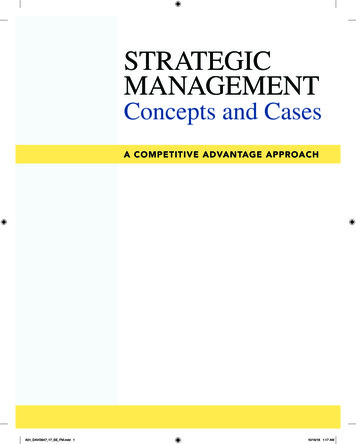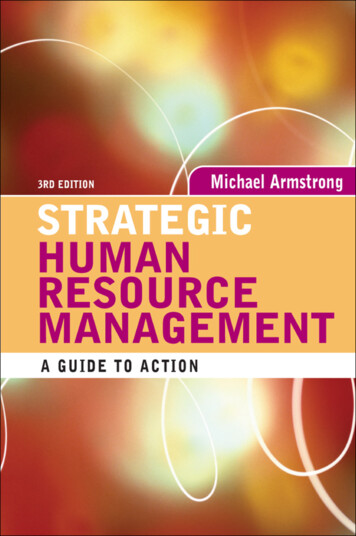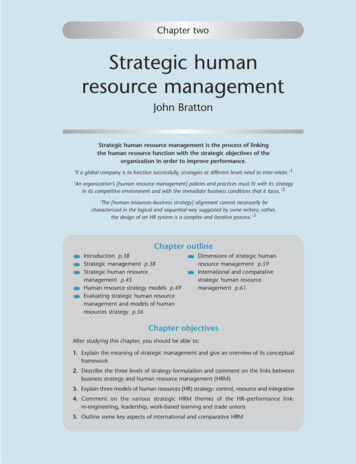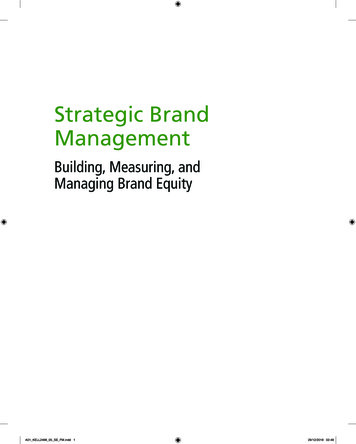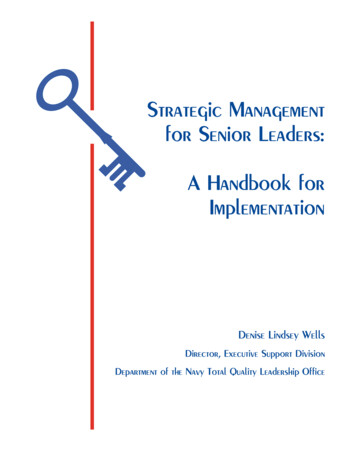
Transcription
Strategic ManagementStrategic ManagementStrategic Management and CompetitivenessByMadireddy VenkatPhD Candidate, SSU, Orisaamvenkat27@outlook.com7/16/2016Created by Madireddy Venkat, itsmcoach@outlook.com1
Strategic ManagementModule Learning ObjectivesAfter the completion of this module learners will be able to: Define Strategy, Competitive advantage, Strategic ManagementProcess Describe vision and mission. Describe Resources and Capabilities, and stakeholders Define core competencies. Describe Strategically valuable resources. Define Strategic Management, Strategic Management Process,Objectives, Policies.7/16/2016Created by Madireddy Venkat, itsmcoach@outlook.com2
Strategic ManagementStrategy Strategy is an integrated and coordinated set of commitments andactions designed to exploit core competencies and gain competitiveadvantage. When choosing a strategy, firms make choices among competingalternatives as the pathway for deciding how they will pursuestrategic competitiveness. In this sense, the chosen strategy indicates what the firm will do aswell as what the firm will not do.7/16/2016Created by Madireddy Venkat, itsmcoach@outlook.com3
Strategic ManagementExample Bharti Airtel focused on single business: telecommunications, that tooin the mobile telephony segment using GSM technology, but withreinforcing presence in basic, broadband, internet service, andinternational telecom businesses. Bharti’s strategic leaders also decided that the firm would pursuecontinuous innovation to stay ahead of its competitors, and that itwould not diversify into any unrelated business, a principle it hafollowed to this day.7/16/2016Created by Madireddy Venkat, itsmcoach@outlook.com4
Strategic Management A firms strategy also demonstrates how it differs from its competitors. Idea cellular is solely in the GSM mobiles business. Each player tries to gain competitive advantage by playing the gamedifferently. A firm must also demonstrate how its game is different.7/16/2016Created by Madireddy Venkat, itsmcoach@outlook.com5
Strategic ManagementCompetitive Advantage A firm has a competitive advantage when it implements a strategycompetitors are unable to duplicate or find too costly to try toimitate. An organization can be confident that its strategy has resulted in oneor more useful competitive advantages only after competitors effortsto duplicate its strategy have ceased or failed. A firm should also understand that no competitive advantage ispermanent.7/16/2016Created by Madireddy Venkat, itsmcoach@outlook.com6
Strategic ManagementResources Resources are inputs into a firms production process, such as capitalequipment, the skills of individual employees, patents, finances, andtalented managers. In general, a firms resources are classified into three categories:physical, human, and organizational capital. Resources are either tangible or intangible.7/16/2016Created by Madireddy Venkat, itsmcoach@outlook.com7
Strategic ManagementResources Tangible resources are assets that can be observed and quantified. Example: Production equipment, manufacturing facilities, hardware,software, server rooms, IT facilities and formal reporting structures aretangible resources. Intangible resources are assets that are rooted deeply in the firms historyand have accumulated over time. Examples: Knowledge, trust between managers and employees, managerialcapabilities, organizational routines, scientific capabilities, brand name,firms reputation for services, how it interacts with people.7/16/2016Created by Madireddy Venkat, itsmcoach@outlook.com8
Strategic ManagementTangible Resources – 4 TypesFinancial Resources The firms borrowing capacity The firms ability to generate internal fundsOrganizational Resources The firms formal reporting structure and its formalplanning, controlling, an coordinating systems.Physical Resources Sophistication and location of a firms plant andequipment Access to raw materialsTechnological Resources Stock of technology, such as patents, trademarks,copyrights, and trade secrets.Source: Adapted from J.Barney, 1991, Firm resources and sustained competitive advantage, Journal of Management, 17, 101.7/16/2016Created by Madireddy Venkat, itsmcoach@outlook.com9
Strategic ManagementIntangible ResourcesHuman Resources Knowledge Trust Managerial Capabilities Organizational RoutinesInnovation Resources Ideas Scientific capabilities Capacity to innovateReputational Resources Reputation with customers Brand Name Perceptions of product quality, durability andreliability Reputation with suppliers For efficient, effective, supportive and mutuallybeneficial interactions and relationshipsAdapted from R.Hall, 1992, The strategic analysis of intangible resources, Strategic Management Journal, 13, 139.7/16/2016Created by Madireddy Venkat, itsmcoach@outlook.com10
Strategic ManagementCapabilities A capability is the capacity for a set of resources to perform a task oran activity in an integrative manner. Capabilities evolve overtime and must be managed dynamicallymanaged in pursuit of above average returns. Capabilities are often developed in specific functional areas (manufacturing, services, R&D, marketing)7/16/2016Created by Madireddy Venkat, itsmcoach@outlook.com11
Strategic ManagementExample of firms capabilitiesFunctional AreaCapabilitiesExamples of FirmsHuman ResourcesMotivating, empowering, andretaining employeesMicrosoft, InfosysManagement InformationSystemsEffective and efficient control ofinventories through point ofpurchase data collectionmethodsWal-Mart, HUL, ITCManagementAbility to envision the future ofclothingEffective organizationalstructureHugo BossManufacturingProduct Design and qualityTata MotorsResearch and DevelopmentDevelopment of sophisticatedelevator control systemsOtis Elevator Co.7/16/2016Created by Madireddy Venkat, itsmcoach@outlook.comPepsiCo12
Strategic ManagementCore competencies Core competencies are resources and capabilities that serve as asource of competitive advantage for a firm over its rivals. Core competencies are often visible in the form of organizationalfunctions. Example: Innovation is a core competence at Apple.7/16/2016Created by Madireddy Venkat, itsmcoach@outlook.com13
Strategic Management Not all of a firms resources and capabilities have the potential to bethe foundation for a competitive advantage. This potential is realized when resources and capabilities arevaluable, rare, costly to imitate and non-substitutable.7/16/2016Created by Madireddy Venkat, itsmcoach@outlook.com14
Strategic ManagementStakeholders Stakeholders are the individuals and groups who can effect the firmsvision and mission, are affected by the strategic outcomes achieved,and have enforceable claims on the firms performance. Claims on a firms performance are enforced through the stakeholdersability to withhold participation essential to the organisationssurvival, competitiveness and profitability. Stakeholder can be separated into three groups: Capital Market stakeholders Product Market stakeholders Organizational stakeholders7/16/2016Created by Madireddy Venkat, itsmcoach@outlook.com15
Strategic ManagementOrganizational Culture Organizational culture refers to the complex set of ideologies, symbols, andcore values that are shared throughout the firm and that influence how thefirm conducts business. It is the social energy that drives – or fails to drive – the organization.Example: Southwest airlines is known for having a unique and valuable culture. Itsculture encourages employees to work hard but also to have fun whiledoing so. The firm also places a premium on service, as suggested by its commitmentto provide POS (Positively outrageous service) to each customer.7/16/2016Created by Madireddy Venkat, itsmcoach@outlook.com16
Strategic ManagementVision Vision is a picture of what the firm wants to be and, in broad terms, what itwants to ultimately achieve. Vision is “big picture” thinking with passion that helps people feel whatthey are supposed to be doing in the organization. Vision statements reflects a firms values and aspirations and are intendedto capture the heart and mind of each employee and hopefully many of itsother stakeholders.Example vision: To be globally respected corporation that provides best of breed businesssolutions, leveraging technology delivered by best-in-class people (Infosys)7/16/2016Created by Madireddy Venkat, itsmcoach@outlook.com17
Strategic ManagementMission The vision is the foundation for the firms mission. A mission specifies the business or businesses in which the firm intends tocompete and the customers it intends to serve. Example (Infosys): To achieve our objectives in an environment of fairness,honesty, and courtesy towards our clients, employees, vendors and society atlarge. Example (TCS): To help customers achieve their business objectives by providinginnovative, best-in-class consulting, IT solutions and services. Make it a joy for allstakeholders to work with us. Example (HCL): "We will be the employer of choice and the partner of choice byfocusing on our stated values of Employees First, Trust, Transparency, Flexibilityand Value Centricity." A firms vision tends to be enduring while its mission can change in light ofchanging environmental conditions.7/16/2016Created by Madireddy Venkat, itsmcoach@outlook.com18
Strategic ManagementStrategically Valuable ResourcesA resource is strategically valuable if: It is hard to copy: Rivals cannot copy resources if they are physically unique, forexample, a desirable real estate location. It depreciates slowly: Disney’s powerful brand name survived almost twodecades of benign neglect between Walt Disney’s death in 1966 and theinstallation of Michel Eisner n 1984. Your company, no employees , suppliers or customers – controls its value: Forexample, your company does not lose critical knowledge when a key employeeresigns. It cannot be easily substituted: Because of easy substitution, the steel industrylost a major market in beer cans to aluminum makers. It is better than competitors similar resources: A maker of medical diagnositicstest equipment designed an easy interface between its machines and people.This design enabled it to expand into doctors offices, where office personnelcould operate its equipment.7/16/2016Created by Madireddy Venkat, itsmcoach@outlook.com19
Strategic ManagementStrategic Management Strategic Management is defined as the art and science offormulating, implementing and evaluating cross functional decisionsthat enable an organization to achieve its objectives – StrategicManagement by Fred R.David, Pearson Education. As this definition implies, strategic management focuses onintegrating management, marketing, finance, production/operations,research and development, and computer information systems toachieve organizational success.7/16/2016Created by Madireddy Venkat, itsmcoach@outlook.com20
Strategic ManagementStrategic Management Process Is the full set of commitments, decisions, and actions required for afirm to achieve strategic competitiveness and earn above averagereturns. This firms first step is to understand the external environment andinternal organization to determine its resources, capabilities, and corecompetencies – the sources of is “strategic inputs”. With this information the firm develops its vision and mission andformulates one or more strategies. To implement its strategies, thefirm takes actions toward achieving strategic competitiveness andabove average returns.7/16/2016Created by Madireddy Venkat, itsmcoach@outlook.com21
Strategic ManagementLong Term Objectives Objectives can be defined as specific results that an organizationseeks to achieve in pursuing its basic mission. Long term objectives means more than one year. Objectives are essential for organizational success because they statedirection; aid in evaluation; create synergy; reveal priorities; focuscoordination; and provide a basis for effective planning, organizing,motivating, and controlling activities. In a multidimensional organization, objectives should be establishedfor the overall company and for each division.7/16/2016Created by Madireddy Venkat, itsmcoach@outlook.com22
Strategic ManagementStrategies Strategies are the means by which long-term objectives will beachieved. Business strategies may include geographic expansion, diversification,acquisition, product development, market penetration,retrenchment, divestiture, liquidation, and joint ventures.7/16/2016Created by Madireddy Venkat, itsmcoach@outlook.com23
Strategic ManagementStrategies in Action (Example from 2004) Krispy Kreme’s revenues have skyrocketed in USA as its number ofstores has grown from 144 in 2001 to 276 in 2003. Now the doughnut company is expanding into Great Britain withplans to open 25 shops there in next five years. But Dunkin Donuts, a major competitor failed in the 1990s in itsattempt to establish stores in Britain. Krispy Kreme believes that it can tailor its doughnuts to Britishculture, as it has in South Korea where it offers fix, mango, and redbean paste doughnuts.7/16/2016Created by Madireddy Venkat, itsmcoach@outlook.com24
Strategic ManagementAnnual Objectives Annual objectives are short term milestones that organizations mustachieve to reach long-term objectives. Like long term objectives, annual objectives should be measurable,quantitative, challenging, realistic, consistent, and prioritized. They should be established at the corporate, divisional, andfunctional levels in a large organization. Annual objectives are especially important in strategyimplementation, where long – term objectives are particularlyimportant in strategy formulation. Annual objectives represent the basis for allocating resources.7/16/2016Created by Madireddy Venkat, itsmcoach@outlook.com25
Krispy Kreme’srevenues have skyrocketed in USA as its number of stores has grown from 144 in 2001 to 276 in 2003. Now the doughnut company is expanding into Great Britain with plans to open 25 shops there in next five years. But Dunkin Donuts, a major competitor failed in the 1990s in its attempt to establish stores in Britain.


